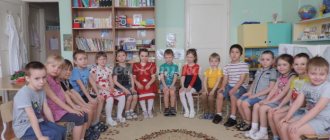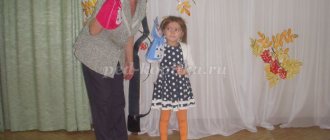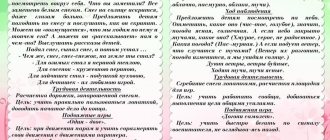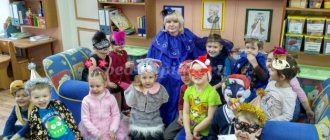Retelling. Lesson notes for retelling in the middle group
Lesson notes on speech development in the middle group “Retelling the story by Ya. Taits “Train” Lesson notes on speech development in the middle group. Retelling the story I. Thai "Train"
Goal: teach children
to retell a short story . Tasks: coherent speech, learn to independently retell a fairy tale convey direct speech expressively ;
Sound culture of speech: clarify. Publication “Summary of a lesson on speech development in the middle group “Retelling a fairy tale. »
Topic: Retelling of K.I. Chukovsky’s fairy tale “Chicken.” Program objectives: 1. Teach children to retell K.I. Chukovsky’s fairy tale “Chicken” together with adults, based on a tabletop theater made from illustrations by the artist V. Kanevsky. 2. Learn to name poultry correctly.
Abstract of the educational activity for the development of speech of younger preschoolers “Retelling the fairy tale “Ryaba Hen”” Retelling the fairy tale “Ryaba Hen” Objectives: coherent speech: teach retelling literary works familiar to children, composing short stories with the help of an adult; vocabulary and grammar: develop the ability to focus on the characteristics of an object. Material: table theater “Chicken.
GCD summary “Retelling the fairy tale “Ryaba Hen” based on a series of plot paintings” (middle group) GCD summary. A retelling of the fairy tale “The Ryaba Hen” based on a series of plot paintings. OO "Speech Development" middle group Program content: Create conditions for psychological and emotional comfort. Systematize children's knowledge about seasonal changes in nature. Develop a skill.
The article “Summary of the GCD “Retelling the fairy tale “Kolobok”” in secondary. » Summary of direct educational activities in the middle group on speech development. Goal: To teach children to retell the fairy tale “Kolobok” using a puppet theater production. Objectives: Retelling the fairy tale “Kolobok” with elements of theatricalization for speech development in middle group 1.
Retelling of the fairy tale “Kolobok” with elements of theatricalization for speech development in the middle group
Botnikova Svetlana Anatolyevna. R. p Lebyazhye Summary of direct educational activities in the middle group on speech development. Goal: To teach children to retell the fairy tale “Kolobok” using a puppet theater production. Objectives: 1. Teach children to participate in dramatization.
Examination of illustrations, reading and retelling of V. Bianchi’s work “Bathing Bear Cubs” in the middle group Examination of illustrations, reading and retelling of V. Bianchi’s work “Bathing Bear Cubs” in the middle group. Goal: Teaching a coherent, sequential retelling of text with visual support in the form of illustrations on an interactive board showing the sequence of events. Tasks.
Source
Retelling. Lesson notes for retelling in the middle group
Retelling of the story by E. Charushin “Hedgehog” in the middle group Summary of GCD in the middle group Retelling of the story by E. Charushin "Hedgehog"
.
Goal: development of monologue speech. Objectives: Educational: Teach children to retell the story close to the text;
teach children to listen carefully to the story; develop the ability to answer questions based on content. Notes on the development of speech in the middle group “Retelling of the story by E. Charushin “Chicken” Retelling of the story by E. Charushin "Chicken"
Learn
to retell the content of E. Charushin’s story “Chicken”
using visual support. Learn to select antonyms (words with opposite meanings, coordinate adjectives with nouns. Continue.
Publication “Summary of a lesson on speech development “Retelling of Russian folklore. »
Topic: retelling of the Russian folk tale “Teremok” Goal: creating conditions for the development of coherent monologue speech. Objectives: Educational: • continue to teach coherent, consistent, expressive retelling of the work; • learn to coordinate adjectives with.
Summary of a lesson on speech development in the middle group “Retelling the story “The Hedgehog” (according to E. Charushin)
SPEECH DEVELOPMENT in the middle group Topic: Retelling the story “The Hedgehog” (according to E. Charushin) Goal: Developing skills in retelling a short text using presentation and graphic diagrams. Main tasks: Formation of skills to answer questions with a phrase of 3-4 words, combine phrases into.
Lesson for the middle group on speech development “Retelling the story “How Kolya got sick” Objectives: · To teach children the initial skill of coherent statements based on a graphic plan. · Develop memory; · Learn to compose sentences, build them in a certain order, without breaking the sequence; · Use direct lexical techniques when retelling.
Summary of a lesson on speech development in the middle group “Retelling the fairy tale “Zayushkina’s Hut” Goal: to develop the ability to retell a work of art using the modeling method. Objectives: 1. Educational: teach children to answer in full sentences, activate their vocabulary, teach them the ability to correlate iconic symbols with images, and name distinctive features.
ECD for the development of coherent speech in the middle group “Retelling the story “Hare’s Fur Coat” based on a picture-graphic plan” Objectives: 1. Activate and update the dictionary on the topic “Wild Animals”. Strengthen the skill of drawing up proposals for a completed action with the preposition “for”. To develop the ability to retell a short story based on a picture and graphic plan. 2. Create conditions for.
Stories for children 4-5 years old
Stories for children in the middle group of kindergarten.
Stories for children of middle preschool age
N. Sladkov “Fun Game”
The fox brought mice for lunch to the fox cubs. And the foxes are full - let's play with the mice. Two people grabbed one mouse and pulled and pulled. And one of them hits three mice at once - whack! Only the tails are hanging.
We played until we got tired of it. Then they abandoned the mice and climbed into the hole. They lay down at the entrance, put their muzzles on their front paws - they look out of the dark hole at the bright world. And they see: flies have flown to the hole. They circled and buzzed. Behind the flies is a wagtail bird. So thin and grey. It shakes its tail and minces with its legs. He will run and stop, he will run and stop. And he stops and wags his tail. He looks at the flies.
N. Sladkov “Why does the fox have a long tail?”
Out of curiosity! It’s not really because she seems to cover her tracks with her tail. A fox's tail becomes long out of curiosity.
It all starts from the moment the foxes' eyes appear. Their tails at this time are still very small and short. But when the eyes appear, the tails immediately begin to stretch out! They get longer and longer. And how can they not grow longer if the fox cubs are reaching with all their might towards the bright spot - towards the exit from the hole. Of course: something unprecedented is moving there, something unheard of is making noise and something unheard of smells!
The old safecracker was sitting on the rubble and playing the violin. He loved music very much and tried to learn to play himself. He did poorly, but the old man was pleased that he had his own music. A collective farmer I knew passed by and said to the old man:
- Drop your violin and grab your gun. You're doing better with your gun. I just saw a bear in the forest.
K. D. Ushinsky “Horse”
The horse snores, curls its ears, moves its eyes, gnaws at the bit, bends its neck like a swan, and digs the ground with its hoof. The mane is wavy on the neck, the tail is a pipe at the back, bangs are between the ears, and a brush is on the legs; the wool shines silver. There is a bit in the mouth, a saddle on the back, golden stirrups, steel horseshoes.
- Sit down and let's go! To distant lands, to the thirtieth kingdom!
The horse runs, the ground trembles, foam comes out of the mouth, steam comes out of the nostrils.
L. N. Tolstoy “Fire Dogs”
It often happens that in cities during fires, children are left in houses and they cannot be pulled out, because they hide from fear and are silent, and from the smoke it is impossible to see them. Dogs in London are trained for this purpose. These dogs live with firefighters, and when a house catches fire, the firefighters send the dogs to pull the children out. One such dog in London saved twelve children; her name was Bob.
L. N. Tolstoy “What dew happens on the grass”
When you go into the forest on a sunny morning in summer, you can see diamonds in the fields and grass. All these diamonds sparkle and shimmer in the sun in different colors - yellow, red, and blue. When you come closer and see what it is, you will see that these are drops of dew collected in triangular leaves of grass and glistening in the sun.
L. Voronkova “The clouds argued in the sky”
Grandma put out the winter frames. And immediately in the hut it became light, cheerful and you could hear everything - sparrows were chirping in the bushes, swallows were chirping, somewhere children were screaming and laughing and roosters were crowing in different voices.
Suddenly the sun somehow became foggy and the hut grew dark. A light rumble echoed over the roof, and a sharp light flashed in the window. Tanya ran outside: “What is this? Storm?!"
G. Snegirev “How birds and animals prepare for winter”
Autumn in the forest. No bird songs can be heard. Fieldfare thrushes have gathered in flocks and are fattening up before migrating to warmer climes.
Crake set off on his journey before everyone else, because he either flies to the south or walks.
The jay buries acorns for reserve. He chooses the ripest ones, but often forgets about them, and in the spring young oak trees grow from these acorns.
The hedgehog found a hole in a rotten stump, dragged leaves into it - and now its housing for the winter is ready.
O. Perovskaya “The piglets who didn’t want to have dinner”
On the state farm, Patya was called a “pig-breeding pig.” This was correct, because her owner, Katya, was a pig farmer and was in charge of a pig farm.
The pig farm was very good. It was a large brick house, with clean whitewashed walls, bare wood floors, electricity, a kitchen and a bathroom.
It was great to live in such a pigsty.
And it’s also very pleasant to manage it.
The nursery was covered with new wallpaper. The wallpaper was very good, with colorful flowers.
But no one overlooked - not the clerk who sold the wallpaper, not the mother who bought them, not the nanny Anna, not the maid Varya, not the cook Pasha, in a word, no one, not a single person, overlooked this.
The painter glued a wide strip of paper at the very top, along the entire cornice. Five sitting dogs were drawn on the strip and in the middle of them was a yellow chicken with a puma-fluff on its tail.
J. Segel “How I Was a Monkey”
When I was no longer very small, but not yet quite big, when I was three and a half years old, dad one day said:
Well, of course, I immediately jumped up and shouted as loud as I could:
Mom was also very happy, but did not scream or jump: for some reason adults are embarrassed to do this.
N. Romanova “The Cat and the Bird”
My red little Kotya (that’s my kitten’s name) was shocked: the bird, a yellow canary, was sitting in a cage in his house, next to him.
The fact is that Koti and the birds had their own relationship, their own account. The cat lived on the ninth floor, birds flew nearby. It seemed as if you stretch out your paw and the bird is yours.
Moreover, the birds sat on the windowsill. Kotka ran as fast as he could, jumped onto the window, but he never managed to catch anyone
V. Dragunsky “The secret becomes apparent”
I heard my mother say to someone in the hallway:



